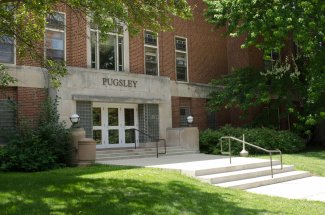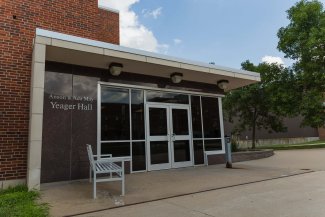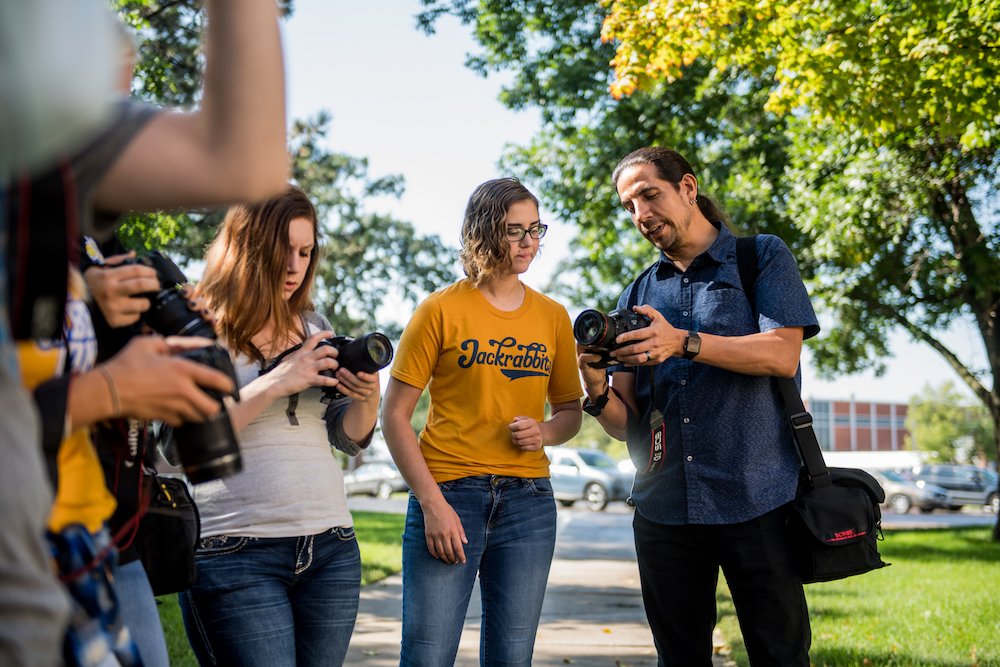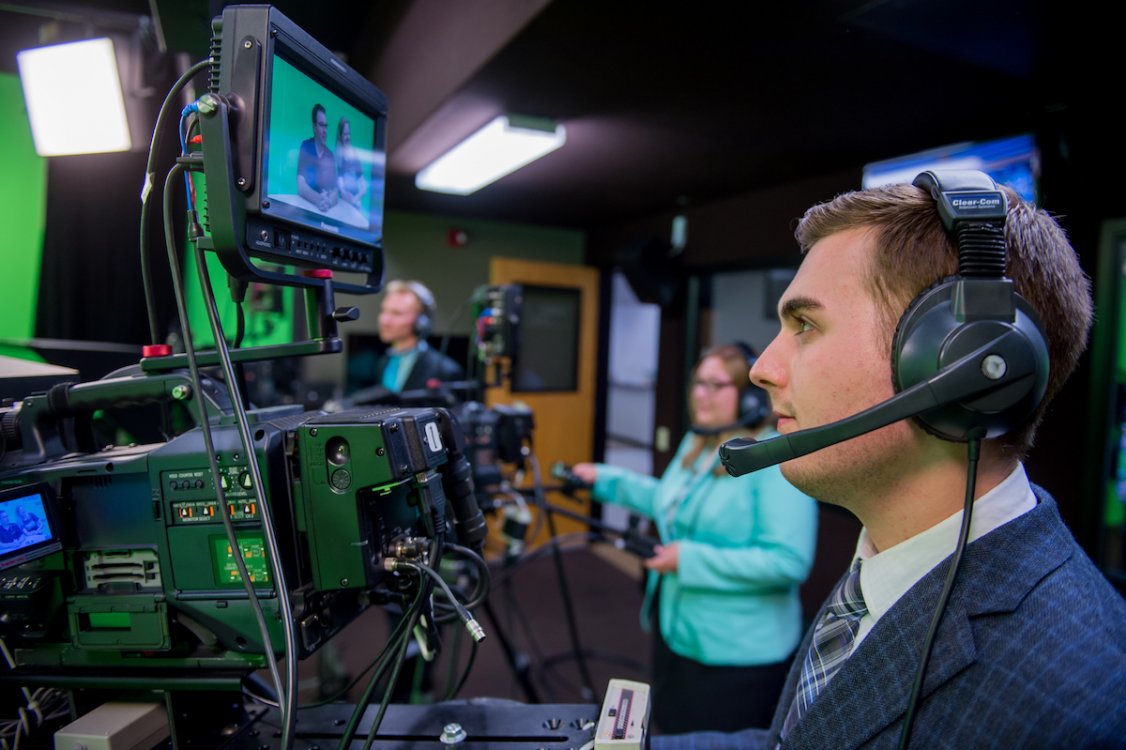History of COJO

The first course in journalism at South Dakota State College was taught in 1908, 27 years after the founding of the college and at a time when journalism courses began to appear in a number of Midwestern state universities. A school of printing began in 1919, and in 1924 journalism professor Charles D. Byrne, who was later the chancellor of higher education for Oregon, moved to combine the work in journalism and the school of printing. The Department of Printing and Rural Journalism began that year.
Professor Byrne reported in the “Northwest Publisher and Printer” the following year that: “Under the present course of study … it was possible for a student to obtain a liberal education and at the same time to receive thorough training in the fundamentals of both journalism and printing.”
Byrne described the product of the program this way: “The publishing of the average country weekly in South Dakota, as well as in some other states, is largely a ‘one-man’ job and will probably continue as such for many years. For that reason, the future publisher must know the mechanical end of his job; he must also thoroughly understand the editorial side of it. And if he hopes to be a real success in rural South Dakota, he must be agriculturally trained, so as to see more clearly the problems of agriculture and their solution.”
During the 1930s and 1940s, a two-year course in printing was combined with three more years in journalism to produce graduates with a bachelor of science in Printing and Rural Journalism — PRJs, they were called.
The department was accredited for the first time in 1948, which was the first year of national journalism accreditation. According to Dean Earl English of the School of Journalism at the University of Missouri, South Dakota State College was the first department to be visited by an accrediting team and recommended for accreditation. In 1951, two years after George Phillips became department head, the present building was dedicated.
In 1956, the PRJ program was shortened to four years and a bachelor of science in printing management began. The same year the department began offering a bachelor of science in journalism and a master of science in journalism.
The department began a master of science in printing management in 1958. For a time it was the only school in the country offering a graduate degree in printing management. Consequently, a number of printing educators hold degrees from South Dakota State. The printing master’s program closed in 1972.
In 1973, professor Phillips retired and was replaced by professor Vernon Keel, who is currently director of the Elliott School of Communication at Wichita State University. The graduate program was suspended between 1973 and 1975 in order to direct efforts toward the undergraduate program. Professor Keel resigned in 1976 to become department head at his alma mater, the University of North Dakota. Professor Ruth Laird directed the department until 1978, professor Richard Lee was head from 1978 to 2002 when professor Mary Arnold was hired. Arnold was head from 2002 to 2017; upon which time Lyle Olson was appointed interim department head. In 2018, the Department became the School of Communication and Journalism and Olson became director. Joshua Westwick became associate director.
In 1978, the Gannett Foundation awarded the department $25,000 and the South Dakota Press Association gave $3,000 toward purchasing an electronic editing system. A Harris system with five VDTs and a microprocessor capable of receiving and storing wire copies was installed in 1980.
Subsequent changes in the early 1980s included electric typewriters in the reporting lab, a Linotype Omnitech typesetter attached to the Harris system and then a seven-terminal Macintosh desktop publishing system, also attached to the Harris system.
By 1989, the Harris system had been set aside. The university provided most of the capital assets and the South Dakota Newspaper Association provided $5,000 to purchase a 10-terminal Macintosh Plus system with a Laserwriter in the editing/typography lab and a 15-terminal Macintosh Plus system in the newswriting lab. The Apple Corporation provided the wiring, network software, printers and Laserwriter as part of the project.
Major Developments in the 1980s
- Establishing the Printing-Journalism Development Fund that continues to provide scholarship, travel, research and equipment support.
- Developing a series of seminars to serve as mid-career training for professionals.
- Being the recipient of 10,000 shares of Gannett stock (at that time worth $375,000) that will eventually establish major scholarship and training programs.
- Beginning the Lusk Lectures in Journalism and the Lusk Fellows.
- Developing programs and ties that were expected to increase Native American enrollment in the department.
Developments in the 1990s
- Increased the number of journalism faculty from seven to nine.
- Changed the male-female balance of the faculty.
- Remodeled both computer labs and has installed Macintosh LC IIIs in the editing/typography lab.
- Recognized nationally for its work in recruiting Native American students.
- Received endowed funding for Lusk programs and for professional seminars.
- Instituted a Journalism Week each spring to give the department and its students higher visibility.
- Became headquarters for the International Society of Weekly Newspaper Editors.
Developments in the 2000s
- Remodeled the former Printing and Rural Journalism Building in a multi-million dollar renovation that added multiple computer labs, student services areas, and new faculty offices. The renovation was funded by many donors, led by a major gift from former Argus Leader editor Anson Yeager and his wife Ada May.
- New leadership was brought in as longtime Department Head Dick Lee retired and was replaced by Mary Arnold.
- Faculty ranks expanded to 11 as student enrollment jumped to more than 300 by 2010.
- The department expanded its programs by offering them at new sites: at University Center in Sioux Falls in 2008 and the online professional master's program in 2009.
Developments in the 2010s
- Added an advertising degree with emphases in creative strategies, interactive media and public relations.
- Added the Yeager Media Center, an HD television production facility.
In the 1904 yearbook from the South Dakota Agricultural College, it shows a Department of Elocution and Physical Culture. Based on the design of the Department of Elocution and Physical Culture:
"To give a symmetrical development of body, mind and soul; to produce public readers and speakers who shall be easy, natural, forceful; to enable its students to adore whatever profession they may choose; to prove that we express no more than we are; to inspire a love for the best in literature; to watch how the best may be expressed."
It seems to be a department of speech and physical education, which is the earliest indication of a speech curriculum at SDSU.
The Department of Speech was formally established in 1923 when it separated from the English Department. This was the national trend at the time. The communication discipline has existed with a formal body of research since 1884; however, the study of elocution and reasoned argument dates back to Aristotle. The Department of Speech became Communication Studies and Theatre in 1992. In 2017, the Department of Communication Studies and Theatre became the Department of Communication Studies when the Theatre Department became part of the newly established School of Performing Arts at SDSU.
The department housed seven faculty members in 1970 and grew to 14 in 1995 when it offered a specialization in communication disorders. This specialization is no longer offered and our department is no longer combined with theatre. Currently, our department is home to five tenure-track faculty and three full-time lecturers who teach the graduate and undergraduate courses in communication. Because of expanding enrollment, the department has also added adjunct and part-time faculty to meet the needs of a growing SPCM 101: Fundamentals of Speech enrollment. In addition, since 1994, the department has consistently staffed at least 13 GTAs to instruct in the SPCM 101 program. As a result, the graduate enrollment and program have grown dramatically. More applicants than assistantships available per year has become the norm in the department.
The department offered a communication studies major and minor. Communication studies majors can also earn a specialization in speech education. Our department also added a health communication minor in 2013, reflecting this growing and vibrant new area of the discipline. The department offered broad service and outreach to the institution and beyond. The department offered an M.S. in communication studies and has a stable enrollment with notable growth in the past 10 years. The generalist degree has been offered for nearly four decades.

Our forensics program is nationally recognized, specifically through the association with Pi Kappa Delta, the national forensics honorary organization. These activities are historical yet consistent with the mission of the department.



